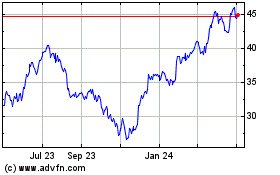By Mike Colias
The Chevrolet Volt is headed to the scrap heap, but during its
decade on the market, the electric vehicle reflected the strengths
and weaknesses of General Motors Co. and auto making in
Detroit.
The plug-in electric vehicle won praise from auto critics who
heralded the car as an engineering marvel when it was introduced in
2010. The acclaim eased some of the pain from GM's bankruptcy at
the time and showed that Detroit could still develop an enviable
vehicle.
The Volt, though, was also a big money loser for GM. It cost a
lot to build and wasn't a big seller because of its high price and
customer skepticism about American-made cars. With a number of
electric vehicles in the pipeline using similar technology, the
auto maker said last month that it would end production of the Volt
by March and idle the Detroit factory where it is built as part of
a broader restructuring.
Still, in its short time, the car developed a small but loyal
following. "It's the best car GM has made in decades," said Volt
owner Sean Hadley, a 45-year-old attorney from New Jersey. He
recently traded in his 2013 model for a 2017 version, and has
persuaded two co-workers to buy Volts.
The Volt can travel about 50 miles in electric mode on a single
charge. But it also has a backup gas-powered generator that kicks
in once the charge is depleted to run the electric motor, allowing
the vehicle to travel another few hundred miles -- a range similar
to a typical gasoline-engine car.
The design offered buyers a novel solution to so-called range
anxiety, the fear of the battery running out of juice before
reaching the destination.
GM showed a prototype of the Volt at the Detroit auto show in
January 2007. Engineers hurried the car through development, eager
to prove GM could compete on environmentally friendly cars with
Japanese rivals like Toyota Motor Corp., said Bob Lutz, a retired
former GM product chief who championed the Volt's development.
"Toyota was seen as the most technologically advanced car
company on the planet, and we were viewed as that bad old American
car company that wouldn't risk anything on new technology," Mr.
Lutz said. "We just had to break that cycle. And the Volt did
it."
Mr. Lutz also said an electric roadster developed by
then-startup Tesla Inc. around that time emboldened him to push for
an electric car based on lithium-ion battery technology.
The Volt's creation became a symbol of GM's emergence from
bankruptcy, a fate precipitated by its heavy reliance on
gas-guzzling trucks and sport-utility vehicles amid soaring gas
prices. The car went on to win awards from car critics, and
President Barack Obama was so intrigued by the car that he took it
for a spin on the White House grounds, breaking the Secret
Service's ban on driving for presidents.
Wall Street Journal columnist Dan Neil wrote in his October 2010
review of the Volt: "A bunch of Midwestern engineers in bad
haircuts and cheap wristwatches just out-engineered every other car
company on the planet."
At the same time, the Volt became a symbol of the Obama
administration's push for electric cars and a lightning rod for
critics of GM's government bailout. A $7,500 tax credit implemented
under Mr. Obama helped make the car more affordable -- it has a
sticker price of roughly $35,000 -- but that credit will start to
phase out in coming weeks, when GM is expected to hit a federal cap
of 200,000 sales.
In November 2010, Washington Post columnist George Will wrote of
the Volt: "People will have to be bribed, with other people's
money, to buy this." President Trump, upset by GM's recent
cost-cutting moves, recently threatened to pull the tax credit for
all electric vehicles.
Even with the tax credit, the Volt struggled to appeal a broader
base of consumers beyond environmentalists and tech-savvy buyers.
U.S. sales peaked in 2016 at a paltry 25,000 vehicles, about
one-fifth the number of Toyota Prius hybrid cars sold that year.
This year, GM is on pace to sell about 20,000 Volts, flat compared
with last year.
The Volt was also a money loser for the Detroit car maker
because it was expensive to make with a high cost battery pack and
the need for both an electric motor and gasoline engine. For a
time, GM was losing $8,000 to $10,000 on every Volt it sold,
according to people familiar with the matter.
GM's decision to drop the Volt has jolted passionate owners,
many of whom take pride in how infrequently they need to fill up
their gas tank. It also stirs memories of the auto maker's first
failed electric car effort, the EV1, which developed a cult
following in the 1990s during the model's three-year run and was
the subject of the 2006 Michael Moore documentary, "Who Killed The
Electric Car?"
GM Chief Executive Mary Barra has said the company believes in
an all-electric future and has several other battery-powered
vehicles coming to the U.S., including an SUV likely in the next
few years.
GM executives have said much of the technology that went into
the Volt, such as electric-motor design and battery cell chemistry,
is being applied to forthcoming electrics. The auto maker plans 20
new models by 2023, most of which will be earmarked for China,
which has strict green-car rules.
Volt owner Chris Hauck isn't interested in waiting. He plans to
trade in his current model for a newer Volt this spring before the
nameplate disappears from showrooms.
The 77-year-old retired electric-utility executive, who lives in
western Colorado, estimated his family has used only 50 gallons of
gas to travel a combined 25,000 miles between his current Volt and
an earlier one.
"We hate to buy gas," he said.
Write to Mike Colias at Mike.Colias@wsj.com
(END) Dow Jones Newswires
December 09, 2018 07:14 ET (12:14 GMT)
Copyright (c) 2018 Dow Jones & Company, Inc.
General Motors (NYSE:GM)
Historical Stock Chart
From Mar 2024 to Apr 2024

General Motors (NYSE:GM)
Historical Stock Chart
From Apr 2023 to Apr 2024
